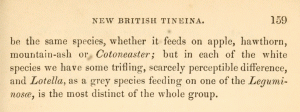2. Diagnose
2.1. Geschlecht nicht bestimmt
2.2. Erstbeschreibung
3. Biologie
3.1. Nahrung der Raupe
- [Fabaceae:] Lathyrus tuberosus [= Orobus tuberosus] (Knollen-Platterbse)
In der Erstbeschreibung wird Lathyrus tuberosus als Raupennahrung angeführt. Für das Artenpaar L. lathyrifoliella / L. orobi werden insgesamt genannt: Lathyrus sylvestris, L. tuberosus, L. latifolius, L. linifolius (= montanus) und L. pannonicus, teilweise auch Vicia spp. Ob es tatsächlich Unterschiede in den Nahrungspflanzen der beiden Arten gibt, ist unklar.
(Autor: Erwin Rennwald)
4. Weitere Informationen
4.1. Andere Kombinationen
- Cemiostoma orobi Stainton, 1869 [Originalkombination]
4.2. Taxonomie
"Leucoptera lathyrifoliella (Stainton, 1866) and L. orobi (Stainton, 1870) are considered distinct species on the basis of constant differences in the morphology of both male and female genitalia. No support was found for literature statements of differences in external appearance between the species. Likewise, the presumed differences in their host plants appear uncertain or erroneous, since both species exploit several host plant species in the plant genera Vicia and Lathyrus."
4.3. Faunistik
Nachweise der Art sind in Estland, Finnland, Lettland und dem Vereinigten Königreich gelungen. (Kaila & Wikström 2004) Die Art ist somit in die Europaliste aufzunehmen.
4.4. Literatur
- Kaila & Wikström (2004): Leucoptera lathyrifoliella (Stainton, 1866) and L. orobi (Stainton, 1870): two distinct species (Lyonetiidae). — Nota lepidopterologica 27 (2/3): 187-192. [PDF auf www.soceurlep.eu]
- Erstbeschreibung: Stainton, H. T. (1870): New British Tineina. — The Entomologist's Annual for MDCCCLXX: 156-159. London (John van Voorst).



![Kein Vorkommen in Österreich [Daten gehören zur abgetrennten Leucoptera lathyrifoliella]](/res/img/flag/at.png)
![Vorkommen in Norwegen (außer Spitzbergen und Jan Mayen) [Aarvik & al. (2017): Nordic-Baltic Checklist]](/res/img/flag/no.gif)
![Vorkommen in Schweden [Aarvik & al. (2017): Nordic-Baltic Checklist]](/res/img/flag/se.gif)
![Vorkommen in Finnland (außer Åland-Inseln) [Aarvik & al. (2017): Nordic-Baltic Checklist]](/res/img/flag/fi.gif)
![Vorkommen in Russland (europäischer Teil bis Manytsch-Niederung) [Kozlov, Kullberg & Zverev (2017)]](/res/img/flag/ru.gif)
![Vorkommen in Estland [Aarvik & al. (2017): Nordic-Baltic Checklist]](/res/img/flag/ee.gif)
![Vorkommen in Lettland [Aarvik & al. (2017): Nordic-Baltic Checklist]](/res/img/flag/lv.gif)
![Vorkommen in Großbritannien [Agassiz, Beavan & Heckford (2013): Checklist of the Lepidoptera of the British Isles]](/res/img/flag/gb.gif)





